This image is in PNG format with a color profile of “Lenovo Thinkpad LCD Monitor” which may correspond to the 1600×900 display of the Thinkpad W520 that it was created on.
Below is the same image in sRGB format which is the unfortunately the standard for computers and the web. It does not look better because it is actually better. In fact it is actually worse. It looks better because your web browser/computer is not properly handling the image above.
Below is the same image convert to Prophoto with the absolute colorimetric rendering intent option. Again, it may look worse than the above image not because it is actually worse. It is actually better. But your web browser may not handle the color profile properly and the Prophoto color profile may not be installed on your computer.
You can probably easily see with your eyes how much “better” the middle image looks. But you are being ripped off. Here is an image of the range of color represented by two of the color spaces above:

One major question we should be asking is: Why are we being ripped off? If it is possible for the hardware of your computer (or other display device such as phone or TV) to actually display these wider ranges of colors, why on Earth would not web browsers be capable of displaying them? In what scenario would any person want their technology device’s display not to display as many colors of the spectrum as absolutely possible? It seems like a no-brainer, yet it is unfathomable that this is the current state of things in 2015.
As an analogy, imagine if your stereo system took the liberty of deciding that you didn’t need to be able to hear certain frequencies of sound. Maybe they are “peripheral” frequencies which are not as “important” or something. Would you accept that from your equipment?
I think the current state of information appliance display technology is kind of a ripoff because on the one hand we consumers are not really being given full information about the physical hardware display devices we use (i.e. the LCD screens) and what they are actually capable of. On the other hand neither is all the software technology we use to transmit and render visual data doing what the hardware is actually capable of rendering which IMHO is inexcusable. Software should never be a bottleneck over hardware. Its understandable that the technology of hardware display technology – mostly LCD technology at this point – still has technical bottlenecks which may limit and distort the range of perceivable colors. But software should not be making the situation any worse than it needs to be.
And this doesn’t just hold for computers either. Cameras also are able to physically sense more colors than the software in them is capturing because most of them are using the same limited color spaces as above (although some more expensive professional cameras do support better color spaces).
People need to wake up regarding colors. Perhaps we are so conditioned to being screwed over if not outright abused by being forced to endure horrific lighting technology that we have simply forgot that we have a right as humans to experience real color.
Please check back with this post as I will change and add content soon.




Leave a Reply
You must be logged in to post a comment.